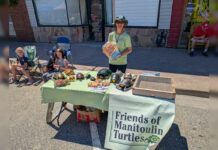LITTLE CURRENT— Members of the Royal Canadian Legion Branch 177 gathered for a number of ceremonies throughout the day on November 11, beginning with a ceremony at Little Current Public School, through the traditional observances both inside at the Legion Hall with the marching in of the colours, wreath laying by local dignitaries and families, the observance of a two-minute silence and the playing of the Last Post by Comrade John Mastelko. The ceremonies at the Little Current hall included a prayer from the new Legion “padre” Father George Gardner and a bugle solo by Manitoulin Sea Cadet CPO1 Bradley Sayyae.
Outside Legion members and cadets gathered to lay a wreath at the Legion cenotaph and the downtown waterfront cenotaph before a light lunch was served. In the later afternoon Legion members held a ceremony at Manitoulin Centennial Manor with the residents that included another bugle performance by Manitoulin Sea Cadet CPO1 Bradley Sayyae, the reading of ‘In Flanders Fields’ and a bagpipe performance by Manitoulin Sea Cadet CPO2 Rebecca MacDonald.
Royal Canadian Legion Branch 177 President Debbie Menard delivered a short synopsis of Canada’s martial history stretching from the War of 1812 and the seminal Battle of Stoney Creek. “The Battle of Stoney Creek (June 1813), many believe, convinced the Americans to abandon any serious attempt at a full scale invasion of Upper Canada,” she noted. “From these humble beginnings we developed a bond of mutual respect between our two nations and we can honestly say that the effective defence of North America is now based on US/Canadian relationship that is a type truly unique in the world.”
Comrade Menard went on to relate how the five incidents known as the Fenian Raids, attacks by Republican Irish supporters based in the US aimed at forcing British withdrawal from Ireland, helped to foster a nascent Canadian nationalism. Nine soldiers fell at the June 2, 1866 Battle of Ridgeway, including three University of Toronto volunteer riflemen. It was the June 2, 1890 protest by surviving soldiers, angry at being forgotten, that ceremonies of remembrance of the fallen evolved and became known as Decoration Day. That annual tradition was eventually eclipsed in 1931, when the November 11 ‘Armistice Remembrance Day’ came into existence. To this day we Remembrance Day on November 11.
Comrade Menard also brought attention to the more recent conflicts the Canadian military has been involved in. “In all, more than 110,000 Canadians have selflessly paid the ultimate sacrifice in the service of their country,” she said. “All are just as worthy of our gratitude for those who, at the call of their country, left all that was dear to them, faced danger and, much too often, passed out of sight of all Canadians through their self-sacrifice giving up their lives so that others may live in freedom and be proud to be Canadian.”
Comrade Menard went on to point out that Remembrance Day “is more than a debt to Canada’s fallen heroes, it is also a duty to the living,” she said. “Indeed, while the number of our fallen heroes is relatively easy to count, the same might not be said about the number of Canadian veterans that have come back broken either physically, mentally or both during these same conflicts.”
Comrade Menard completed her address with an impassioned call to all Canadians to support the Legion poppy campaign. “By wearing the poppy,” she said. “Our veterans will see that their efforts and sacrifices are not in vain. They will know, we will remember them.”






